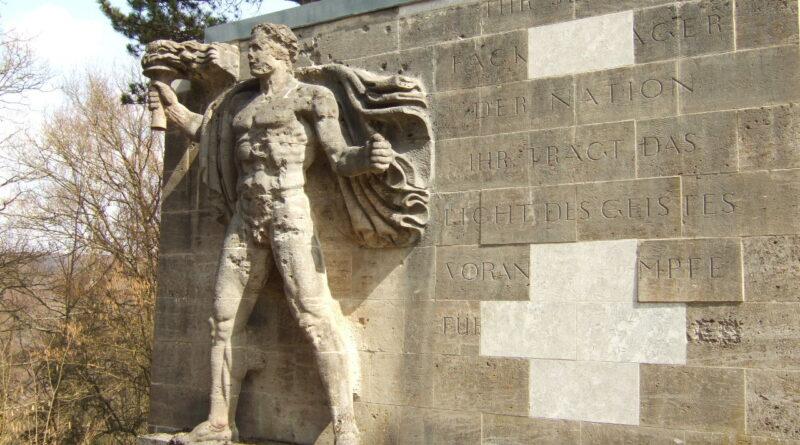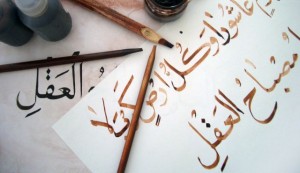The birdsong of Nazi propaganda that shook Europe
The former Nazi social engineering complex known as Vogelsang Ordensburg offers us a timely reminder of how vulnerable democracy can be in the face of extremist ideology.
That fascism rose in post-depression Germany was no fluke. That it inspired a cult of racial exceptionalism was down to a group of social engineers who set out to ‘educate' a generation of future Nazi party leaders, the so-called ‘knights of the order' (Ordensjunker).
Described today on travel websites as thought-provoking, challenging, fascinating, and even scary, Vogelsang Ordensburg (which means the Birdsong Order's fortress in German) was one of four planned facilities charged with carrying out that duty. It is a rare place that draws attention to itself by its very existence, yet strives to keep its telling of the story of National Socialism in 1930s Germany as dispassionate as history and the public will allow.
Located a stone's throw from the Belgian border, the sprawling Vogelsang site overlooking the Urft Reservoir is an unflinching reminder that pluralism and democracy are never to be taken for granted. And never more so than today as war ravages Ukraine, and the twin ills of nationalism and populism continue their spread across Europe, and beyond.
At the entrance to the visitor centre occupying the former Adlerhof (eagle's courtyard) of the Vogelsang site, now rather plainly called the ‘International Place', is a room dedicated to silence and peace. This is a poignant opener to the dedicated exhibition much less plainly entitled ‘Destiny: master race. National Socialism Ordensburgen – both fascination and crime'. It sits perhaps as dark is to light beside a child-friendly exhibition on the flora and fauna inhabiting the surrounding Eifel National Park.
Your correspondent waded into the dark side first, reading with trepidation that “the exhibition does not aim to give simple answers”, but rather it seeks to “encourage questions” on the sensitive topic of National Socialism during the period leading up to World War II and the tragic events that unfolded.
The guidebook to the exhibit poses several hypothetical questions to get visitors thinking: What drew these young Germans to Vogelsang? What did they hope to achieve? Did they all become Nazis and commit war crimes? It focuses largely on the recruits – selected by the leaders of the Nationalsozialistische Deutsche Arbeitpartei (NSDAP), or the National Socialist German Workers' Party in English – to be moulded into the future Nazi party elite. It explores their desires and ambitions, life at Vogelsang, the struggles of the movement, and their later involvement in the war.
Improvised order
Adolf Hitler was appointed Chancellor of the Reich in January 1933 and quickly set about establishing a political Gleichschaltung, a forcible coordination of public life in Germany, led by NSDAP's guiding hand. When Reich Organisation Leader Robert Ley joined the Chancellor on a visit to a “trade school” in Bernau bei Berlin, they reached the conclusion that more ambitious academies were needed to prepare the next generation of political soldiers. Ordensburg Vogelsang in North Rhine-Westphalia and its sister schools, Ordensburg Sonthofen in Bavaria, Ordensburg Krössinsee in Pomerania, and Marienburg Castle in West Prussia were commissioned shortly after. Ultimately, only the first three became operational. Vogelsang was formally opened in April 1936 in a handover ceremony attended by Hitler himself.
Students in their 20s and preferably married (or soon to be) were expected to complete a four-year programme, attending all four institutions in sequence, and finishing at the already existing Marienburg castle for final live-fire military training. Many of the 500-plus recruits saw their inclusion in the Ordensburgen programme as a stepping stone to social and professional advancement. They were schooled in spiritual, physical, sociological and racial ideology, shaping what the exhibition calls “a new human of the future” – a template for the “Aryan Master Race”.
But all around there was a sense of a work in progress. “During the three years that courses [actually] took place at Vogelsang, the Ordensburg remained a permanent construction site,” note the guidebook's authors.
Reports of teacher shortages, improvised course content, and criticism about an overemphasis on physical rather than intellectual rigours swirled within the Nazi party. Fewer applications and growing dropout rates dogged the programme. But these failings were drowned out by propaganda reels of visiting foreign delegations from Italy, Romania, and Japan admiring the “pioneering” qualities of the training facilities.
Branding was a feature from the start. Building the sites with castle-like features and calling the recruits knights of the order was a direct homage to mediaeval Teutonic Knights. Sculptures and reliefs, such as the naked torchbearer by artist Willy Meller on the school's Sonnwendplatz, drew on the powerful symbolism of the period. The Nazis also organised highly visual political ceremonies to project the movement's strength, co-opting traditional events like May Day into National Socialist theatre.
“The NSDAP's veneration for its leader [the Chancellor] and ceremonial self-presentation […] gradually grew into a political cult,” notes the guidebook. “It affected all areas of society and showed characteristics of a substitute religion.” In Vogelsang this was embodied by the larger-than-life Meller sculpture, the “naked hero” symbolising the archetypal “German man”.
The site was also used to educate grammar students aged 12 upwards, as part of the Adolf Hitler School system set up in 1937. The idea being that Hitler's grammarians would form a pool from which future Ordensburgen intakes would be selected. But Germany's invasion of Poland in September 1939 put an end to those plans and the so-called knights were folded into the war effort.
Most joined the Wehrmacht's rank and file and were deployed in various units and war zones, while some former students were retained as Nazi party officers. Due to their National Socialist programming, it has been reported that they were “particularly motivated” frontline soldiers – indeed, fewer than a third of the Ordensjunker survived the war.
“With [their] ideological background, the men from the Ordensburgen initially went into the World War II as soldiers – a war that quickly became a war of racial extermination, particularly in the East,” notes one of the translated exhibition texts.
Several hundred Ordensjunker were deployed in Eastern Europe as party-loyal administrators and organisers of the “economic exploitation” and “ghettoisation of the Jewish population”.
“Many of them were to play an active part in National Socialist crimes there,” the text continues, adding that it took a “very long time before post-war society and ultimately the judicial system began to take an interest in individual perpetrators.”
Nevertheless, various Ordensjunker were brought to justice shortly after the war ended. In 1948, for example, Franz Murer received 25 years' hard labour from a Soviet court for his role as deputy district commissioner of the Vilnius ghetto. A German court gave a life sentence to another of the alumni, Gerhard Erren, who was district commissioner for the Slonim ghetto in Belarus, where mass killings took place.
The top echelons of the NSDAP didn't escape notice either. As the Nazi party's chief ideologist and Reich Minister for the Eastern Occupied Territories, Alfred Rosenberg was indicted at the Nuremberg Trials. For his war crimes, he was sentenced to death and executed in October 1946.
Others were put into detention and underwent a “denazification” programme. The surviving members of the order who were not accused of war crimes blended back into German society until the 1950s when a loose network of “former comrades” started meeting to support each other and exchange news via a regular newsletter.
From the 1970s onward, some members of this alumni would return to the Vogelsang for nostalgic reasons, the exhibition text reveals, “often enough without any visible evidence of remorse or regret”. The reunions lasted until the mid-1990s. Although the group was not an “openly right-wing heritage association”, the guidebook adds, “quite a number of the early Ordensjunker mourned the downfall of the Third Reich”.
War-time till now
The whole site was vacated by the Germans ahead of American advances following the June 1944 D-Day landings, reaching Vogelsang around September-October. While the main facility received some war damage, key buildings were largely intact and put to use by Allied military forces; first the US and later, in the summer of 1945, the British.
The Brits passed the facility over to the Belgian military in 1950 who then renovated and added new buildings, including a large barracks and cinema complex. The Belgians handed back the “military training area” to Germany in 2005, marking a new beginning for Vogelsang as a “future-oriented International Place”.
An improvised visitor centre was opened in 2006, and in 2012 work started to transform the Alderhof into the Forum Vogelsang IP comprising a book store, twin permanent exhibitions, temporary exhibits, and signposted tours of the interior and surrounding grounds and woodlands.
Complex nature of heritage tourism
Online tourist reviews clearly reflect Vogelsang's challenging historical context and the complex nature of heritage tourism, as further evidenced by movements aimed at removing statues and remnants of questionable historical figures and events in the US and Europe.
Indeed, one visitor expresses relief that obvious Nazi paraphernalia had been removed or contextualised around the site, but noted that much of the social realism iconography remains in-situ, offering food for thought on the doctrines they represented – and indeed the lessons they continue to impart.
Ancient myths, Romantic concepts and philosophy were distorted by National Socialist leaders and, in turn, Nazi propagandists into a “perverted ideology”, suggests Christa Kamenetsky in a 1972 Metaphilosophy article (see JSTOR digital library). She says the expropriation of three ideas – Volk, Gemeinschaft, and Weltanschauung (people, community, and worldview) – offers unique “insight into the borrowing practices of the Third Reich”.
More recently, a visitor from the Netherlands touches on the complexity and sensitivity of maintaining a heritage site like Vogelsang: “It is great that the Ordensburg is opened to the public and the history is told and explained. The exhibition is transparent and clear, but lacks a little disapproval of what happened here.”
One reviewer says it is a must-see for the “deep insight” it offers into the “dark side of German history”. While another calls it out for being too politically correct. “This is not only a museum about history during the Reich but also how apologetic historians deal with it,” the visitor writes. “Only in the last two stations of the tour the holocaust and war crimes are mentioned [sic]. The fact that the Nazis were a criminal organisation from the beginning is omitted.”
A Danish reviewer takes the site – its historical significance and its impressive natural setting – at face value: “What a place! So historical! So Beautiful! What a location! The most beautiful area and surroundings. And what a scary place. So much information about the Nazis and all the crap [they] taught young men in the 1930s.”
The guidebook frames it rather differently: “Finally, questions remain which deliberately go beyond the history of National Socialism: how would we have thought ourselves and how would we have acted had we been placed in a similar era and given a similar task? Are there comparable situations in the world today or in our environment? What do democracy and pluralism mean in our own society?”
Your correspondent's take is that we don't have to look too hard to find unflattering examples on Europe's doorstep, where autocratic leaders impose their will, interfere with institutions, obstruct media pluralism, harass their neighbours, and polarise populations. Unless countered, malevolent birdsong carries far and wide.
________
Other articles by Ray O'Reilly


